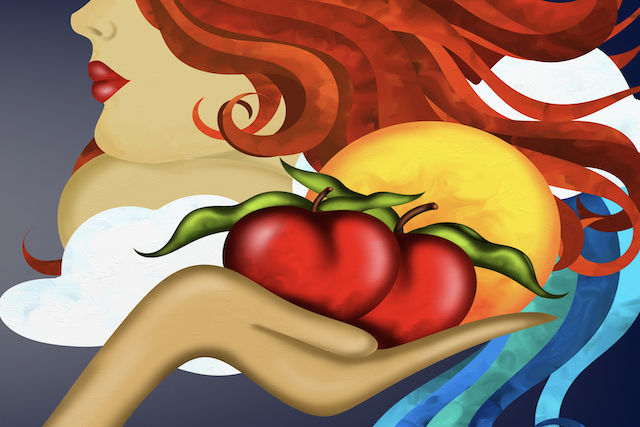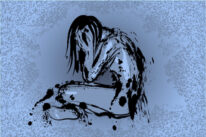
“Food can distract you from your pain but food cannot take away your pain.” ~Karen Salmansohn
Long before I was watching The Biggest Loser (a popular weight loss reality TV series) and trying to look like a swimsuit model, I was hiding in my closet eating candy, fiercely addicted to sugar.
I remember feeling completely out of control over my cravings for all things sweet, and I didn’t know how to stop myself from eating until I felt sick. Food played a bigger role in my life than simply to support the processes in my body that lead to optimal health. To my “child self,” who wasn’t sure the world was a safe and welcoming place, food was a lifeboat.
No little kid imagines, “Oh, it would be fun to starve myself and see what happens!” Or enjoys waking up in the middle of the night to work out for hours for the reward of being “loved” by those around them. But when faced with adversity in childhood, our number one goal is to survive, and in order to do so, we look for ways to reassure ourselves that we have some element of control.
I grasped for anything I could to create a sense of agency and stability in my life, but at the cost of disconnecting from my inner wisdom and abandoning the core of who I was created to be. I was trying to survive by becoming less. Less of myself, less visible to the world around me, while at the same time crying out to be seen.
As you consider your own childhood experiences with food, notice any emotions that come forward. How old were you? What was the backdrop in which these early experiences with food occurred?
As I reflect on my own food story, I see how my emotional pain and a complicated relationship with food became intertwined. It was one of the only levers I could pull to manage the chaos both in my home and within myself.
What appeared on the surface as a “fear of food” was in truth a fear of feeling. Feeling meant facing the ache of growing up in a home where strong emotions were suppressed, intuition ignored, and many conversations critical for the healthy maturation process of an adolescent, avoided.
For example, any discussion around the topic of sexuality and what it meant to embody and express mine, was considered “taboo,” and shameful in the highly religious culture of my upbringing. Therefore, it is no coincidence my disordered eating patterns surfaced in tandem with my body’s transition into puberty.
The changes in my body, at that time, felt terrifying, and the disordered eating served as an attempt to shut down the process of sexual maturation—a means to avoid the shame of being “sexual.”
In my rehabilitation process from anorexia, bulimia, and orthorexia I found again and again that behind a binge, purge, or restrictive behavior was often a deep emotional pain I felt ill-equipped to meet and care for in a healing manner.
Disordered eating was “pain-management.” Albeit not the most effective strategy for coping with distress, but it was the one I knew inside and out.
The first time I recall recognizing disordered eating as a way to handle emotional turmoil, I was sitting in therapy feeling guarded and hesitant to believe that the healing answers lived anywhere in that room. I didn’t fully understand why I was there, aside from being told it was the “right” thing to do to get professional help.
The therapist looked at me with concern in her eyes and asked, as if the answer should be simple, “Why are you so afraid of food? Why the eating disorder?”
Now, I’d been asked that question by many well-meaning, worried adults before, but on this day, I felt an unexpected flood of emotion rise within, and fighting back tears, I replied,
“I’m not afraid of food. I’m afraid my parents will divorce.”
The moment the words left my mouth, I realized the question my heart had been desiring for someone to ask all along was: “Why the pain?”
Think back to your childhood home and the role food played, beyond physical sustenance.
Was food a reward for good behavior?
Did food cause fights between your parents (i.e., one parent burns dinner, and the other explodes in anger)?
Was food used as a way to “regulate” you—help you “calm down,” feel comforted when you were sad, or numb pain?
When you faced challenges, was food more available than the ears of the adults in your life?
Did you feel safe in your childhood home to express internal pain?
Furthermore, if you grew up in an intense emotional climate, and your primary caregivers lacked the level of consciousness, and resources, to support you in learning healthy emotional regulation, food might have been the only “state-changer” (the only thing to take the edge off painful experiences) available. Food was your therapy.
Emotions ended up being “fed” instead of felt. Eating became a way to cope with the feelings that seemed out of control in your life. Instead of fueling your body with the building blocks required for healing, you ate to numb your pain.
Hear me when I say, there is no shame if you find yourself here—if you’re still stuck in the cycle of using food to survive your own emotional experience. You’re worthy of self-compassion—to be able to look back at your younger self and appreciate the ways you managed the pain you faced, with the resources you had. Whole-body rehabilitation starts by offering gentleness toward oneself.
Another critical component of healing is giving yourself permission to have the conversations with yourself that, as a child, you didn’t or couldn’t have with others, but longed to. Doing so aids in establishing a “safe” environment within yourself for healing to flow. Set yourself free to explore any and every question that feels important to you.
As I mentioned earlier, for me one such conversation was around what it meant to be a sexual being. For you this might mean exploring the confusion you felt when your parents split and the challenges you faced adjusting to new blended family dynamics, the loneliness you experienced as a child because it was hard for you to make friends, or a sense of shame about your family’s socioeconomic status.
And if it was normal in your family of origin to bury and suppress half of the emotional spectrum, as it was in mine, especially the feelings that are uncomfortable, that require deeper self-inquiry, think about whether this culture aligns with your core values, now.
What culture do you desire to cultivate for your future self around navigating emotional pain? This is your opportunity to excavate a new tunnel from which to travel from emotional pain to healing, for you and generations after you!
Right now, you have an opportunity to build trust with yourself by committing to allowing every emotion to be experienced. What is one emotion that you believed as a child was “off limits?” What would change today if you allowed yourself to experience that emotion—to permit its flow through you?
Listen to the little voice within you, with your heart wide open. Witness yourself. Be the listening ear you longed for when things first got “complicated” with food. Only then can you ask your younger self if they’re ready to entertain some alternative strategies, besides food, to help scary emotions move through the body.
And when you are ready, here are some of the beautiful practices I have found on my own healing journey, that aid in building a space where the body feels free to release big feelings:
1. Jin Shin Jyutsu- Finger Holding Practice
This Japanese healing technique works to calm your energetic body. The practice involves holding each finger for one to three minutes on one hand, then repeating on the other hand. Each finger represents a different emotion:
Thumb- Worry
Pointer Finger- Fear
Middle Finger- Anger
Ring Finger- Insecurity and grief
Pinkie- Self-confidence
2. The 4-7-8 Breath or “Relaxing Breath”
One benefit of this breath practice is its ability to strengthen “vagal tone.” The Vagus Nerve is the longest group of nerves in the body, running from your brain to your gut, and it is a key component in the activation of your parasympathetic nervous system—the branch of the autonomic nervous system that promotes the resting, digesting, and repairing in the body. Improving vagal tone can play a role in reducing stress and anxiety as well as:
- Improve digestive health
- Increase HRV (Heart Rate Variability)
- And lower levels of inflammation in the body
3. Walking outside barefoot
Reconnecting to our roots, putting feet to earth, and absorbing the healing nutrients it has to offer can do a world of healing. When you put your bare feet on the earth, the electrical current coming from the ground contains an abundance of negative ions that are then absorbed by your skin and dispersed throughout the body. These negatively charged ions have been shown in clinical research to promote greater physical and psychological well-being.
Try one or all of the techniques listed above to reconnect to your emotional body, ground yourself, and release stuck feelings. Notice any shifts you experience as a result.
The goal is to start to create an environment of safety for your inner child to explore the previously forbidden emotions, without fear of abandonment or shame.
No different from any other coping strategy, disordered eating can be a means to try to create the safety within that we lacked in our outside world early on in life. But there are other interventions, such as the ones mentioned above, that can offer a sense of safety without harm.
Recovering from disordered eating comes back to finding healing ways to be there for your emotions, rather than numb them with food restriction, binging, or purging. Because it’s really not about the food at all. It’s about becoming the friend your body longed for in your most painful moments.
Give your body a safe place to express, let go, and experience, without judgment, the total expanse of feelings that come with being human, and watch your relationship with food transform as a side effect.
About Erika Wirth
Erika Wirth is a Body-Partnership Coach, supporting others in restoring health to the body by building a trusting friendship with it. She’s also the host of the Wirth Wellness Podcast, where she has interviewed experts on a wide range of health and wellness topics including anxiety, balancing hormones naturally, ancestral nutrition, Internal Family Systems, Emotional Freedom Technique, natural conception, and gut health. She holds a BSc(Psych) from Thomas Edison State University. Find her on Instagram here.













 Though I run this site, it is not mine. It's ours. It's not about me. It's about us. Your stories and your wisdom are just as meaningful as mine.
Though I run this site, it is not mine. It's ours. It's not about me. It's about us. Your stories and your wisdom are just as meaningful as mine. 